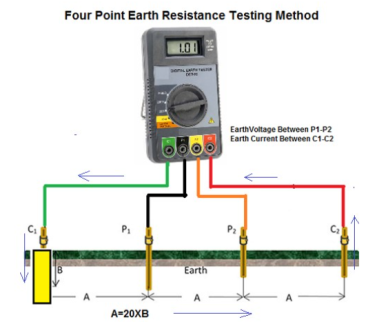|
P/P+Q. I[ R + p/(p+q) { (p+q)r/ p+q+r}] = I[pr/p+q+r] R= P/Q.S + pr/p+q+r[ P/Q -p/q] As we known, P/Q = p/q then above equation becomes R=P/Q.S |
The bridge is said to be balanced when there is no current through the galvanometer or when the potential difference across galvanometer is zero. The balanced condition occurs when voltage from point b to point a equals to voltage from point d to point b or by referring to the other battery terminal when the voltage from point d to point c equals the voltage from point b to point c.
|
where E = emf of the battery
Combining the above three equations we get, P/P+Q = R/R+S --------------------------------(4)
from which Q.R = P.S ----------------------------------------------------------------(5)
If three resistance are known, the unknown resistance can be obtained by
R = S*(P/Q)
Q3) Explain the measurement of high resistance?A3) Megohm Bridge Method:
|
|
|
|
|
|
R1R4+L1/C4=R2R3 and L1 =R1/w 2 R4C4 Solving the two equations we have L1 = R2R3C4/1+w 2 C42 R4 2 ---------------(1) R1 = w 2 R2 R3 R4 C4 2/ 1+ w 2 c4 2 R4 2 ----------------------------------------------(2) The Q factor of the coil is Q=wL1/R1 = 1/wC4R4-------------------------------------(3) |
|
|
(r1+1/jwC1)(R4/1+jwC4R4) = 1/jwC2.R (r1+1/jwC1) R4 = R3/jwC2(1+jwC4R4) r 1 R4 -jR4/wC1=-j R3/wC2+R3R4C4/C2 Equating real and imaginary terms we obtain r 1 = C4/C3 .R3 C1 = R4/R3. C2 |
Dissipation factor D1 =tan ɸ=wC1r1=w.R4/R3 .C2.C4/C2 .R3 = wC4 R4 |
|
At balance (R1/1+jwC1R1) R4 = (R2-j/wC2) R3 R4/R3 = R3/R1 + C1/C2 + j(wC1R2 -1/wC2R1) Equating real and imaginary terms we get R4/R3 = R2/R1 +C1/C2 And wC1R2 -1/wC2R1 =0 from which w=1/√R1R2C1C2 and Frequency f =1/2π√R1R2C1C2 . In most Wein bridge the components are chosen such that R1=R2=R and C1=C2=C Therefore R4/R3 = 2 F=1/2πRC |
|











